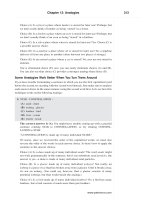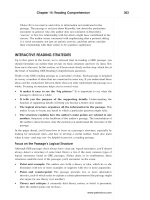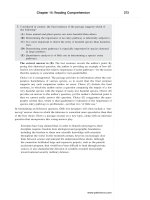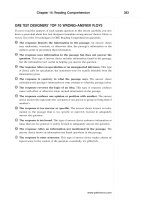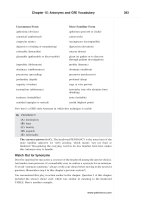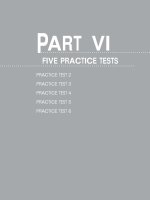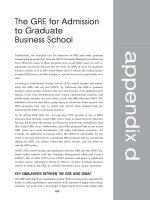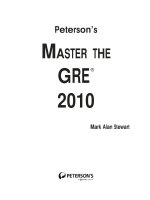Master the Gre 2010 - Part 38
Bạn đang xem bản rút gọn của tài liệu. Xem và tải ngay bản đầy đủ của tài liệu tại đây (55.87 KB, 10 trang )
SUMMING IT UP
• The GRE Verbal Reasoning section contains two types of Sentence Completions:
single-blank and dual-blank. You are required to complete the entire sentence by
selecting the best pair among five choices.
• Your Verbal Reasoning section might also contain a more complex Text
Completion test item, a brief passage with either two or three blanks. Your job is
to select the best among three choices for each blank. You complete each blank
independently of the other(s), and you must complete all blanks correctly to
receive credit for a correct response.
• Sentence and Text Completions test your ability to understand the intended
meaning of a sentence or paragraph, your ability to distinguish between a sen-
tence or paragraph that makes sense and one that lacks sense, your ability to
recognize and distinguish between proper and improper word usage and idiom,
your ability to recognize and distinguish between clear and unclear written
expression, and your vocabulary.
• The emphasis on vocabulary is not as strong with Sentence and Text Completions
as with Analogies and Antonyms.
• Follow and review the five basic steps for handling GRE Sentence Completions
and the four basic steps for handling GRE Text Completions outlined in this
chapter. Apply them to this book’s Practice Tests; then review them again just
before exam day.
Chapter 13: Sentence and Text Completions 353
.................................................................
..............................................................................................
www.petersons.com
Reading
Comprehension
OVERVIEW
• Key facts about GRE Reading Comprehension
• Interactive reading: The key to reading comprehension
• The 7-step plan
• Interactive reading strategies
• Question types
• GRE test designers’ top 10 wrong-answer ploys
• Summing it up
In this chapter, you’ll focus initially on reading and understanding GRE
Reading Comprehension passages. Specifically, you’ll learn the following:
• Why it’s important to read the passages “interactively”
• A step-by-step approach to reading and comprehending passages
• Techniques for reading the passages more effectively and efficiently
Later in the chapter, you’ll shift your focus to the questions themselves. In
particular, you’ll learn how to recognize and handle all the question types that
appear most frequently on the GRE. For each question type, you’ll learn how
the test makers design wrong answer choices, and how to recognize them
when you see them.
At the end of the chapter, you’ll review key strategies and tips for success in
GRE Reading Comprehension.
KEY FACTS ABOUT GRE READING COMPREHENSION
You last looked at GRE Reading Comprehension in Chapter 2 and in this book’s
Diagnostic Test. Here’s a quick review of key facts about this question type.
Where: The 30-minute Verbal Reasoning section, mixed in with other
question types
How Many: Approximately 8 questions, based on 2–4 passages (2–4 ques-
tions per passage)
chapter14
....................................................................................
355
What’s Tested:
• Your ability to read carefully and accurately
• Your ability to determine the relationships among the various parts of the
passage
• Your ability to draw reasonable inferences from the material in the passage
Specific Abilities Measured: GRE Reading Comprehension questions measure the
following specific abilities:
• Recognizing the main point or concern of the passage
• Recalling specific information from the passage
• Making reasonable inferences from specific information in the passage
• Recognizing the contextual purpose, function, or meaning of specific passage
information
• Recognizing the structure and methods an author employs to convey the ideas in
the passage
• Applying the ideas presented in the passage to new situations
Directions: During the computerized GRE, test directions similar to the following
will appear on your screen prior to each set of Reading Comprehension questions:
Directions: The questions accompanying the following passage are based on the
passage’s content. After reading the passage, choose the best answer to each
question. Answer all the questions on the basis of what is stated or implied in the
passage.
Other Key Facts:
• Passages are condensed, edited excerpts from larger works in the biological
sciences, social sciences, and humanities.
• Prior knowledge of a passage’s subject matter is not important; all questions are
answerable based solely on the passage’s information.
• Passages appear on the left side of your computer screen; questions based on the
passage appear (one at a time) on the right side.
• You’ll need to scroll vertically to read an entire passage on the computer screen.
• Passages range from approximately 175 words (15–20 lines on the computer
screen) to 450 words (45–50 lines).
• Expect to see at least one short passage and at least one long passage on your
exam.
• Questions about information appearing early in a passage do not necessarily
come before other questions.
PART V: Verbal Reasoning356
.................................................................
..............................................................................................
www.petersons.com
INTERACTIVE READING: THE KEY TO READING
COMPREHENSION
If you’re like most GRE test takers, you’ll experience at least one of the following
problems as you tackle the Reading Comprehension part of the GRE, at least to some
degree:
• Your concentration is poor, perhaps because you’re unfamiliar with or uninter-
ested in the topic, or maybe because you feel test anxiety.
• You read slowly, so you have trouble finishing the Verbal Reasoning section
within the time allotted.
• To answer each question, you need to search the passage several times to find the
information you need.
• You have trouble narrowing down the answer choices to one that’s clearly
the best.
Believe it or not, all of these problems stem from the same habit, which we’ll call
passive reading. This means that you simply read the passage from start to finish,
giving equal time and attention to every sentence, without thought as to what
particular information might be key in answering the questions. You might call this
approach the “osmosis strategy,” since you’re hoping to absorb what you need to know
by allowing your eyes to gaze at the words as you read.
The likely result of this habit, however, is that all you’ll remember are some scattered
facts and ideas that help you respond correctly to some questions. The passive reading
habit won’t help you answer questions that measure your ability to understand the
ideas in the passage rather than to simply recall information. Understanding a
passage well enough to answer all the questions requires a highly active frame of
mind in which you constantly “interact” with the text as you read, asking yourself
these three key questions:
• What is the passage’s central idea (or thesis) and the author’s overall concern or
purpose?
• How does each part of the passage relate to the main idea and author’s overall
purpose?
• What is the author’s line of reasoning, or so-called train of thought?
Interactive reading is the key to handling GRE Reading Comprehension—and that’s
what the first portion of this chapter is primarily about.
Chapter 14: Reading Comprehension 357
.................................................................
..............................................................................................
NOTE
The interactive reading
techniques you’ll learn early in
this chapter apply to any
reading passage, regardless of
topic or length, and they’ll
help you handle any question
type the test might deal you.
www.petersons.com
